Family : Sphyrnidae

Text © Giuseppe Mazza

English translation by Mario Beltramini
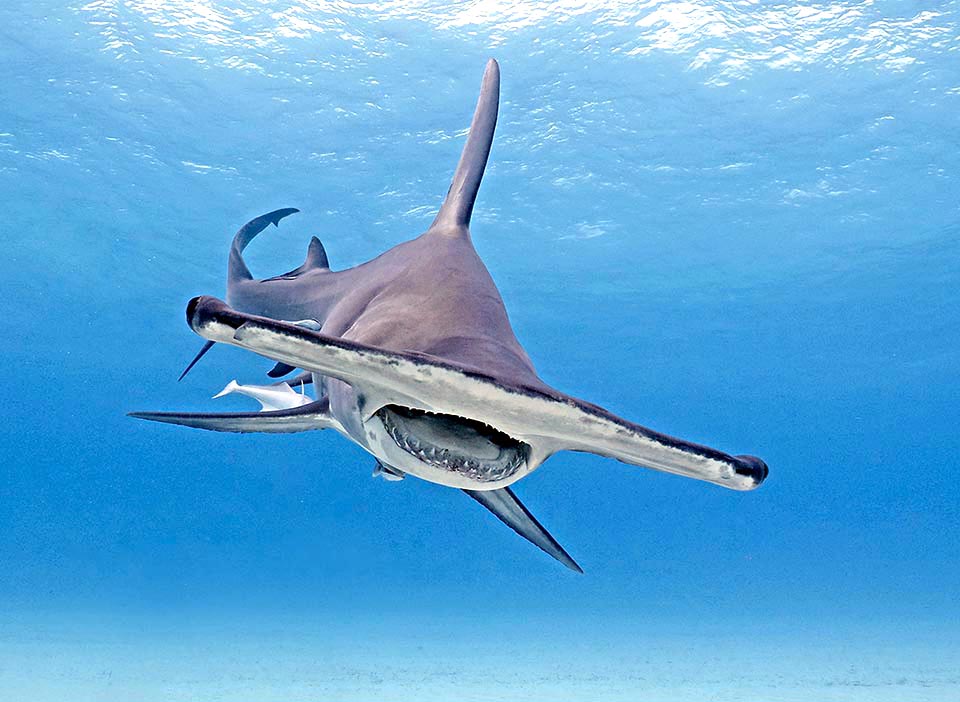
Present also in Mediterranean, the Great hammerhead (Sphyrna mokarran) circulates in almost all tropical and warm temperate seas © Michael Eisenbart
Known, due to its size, as Great hammerhead or, due to the square shape of the head, as Squat-headed hammerhead shark, Sphyrna mokarran (Rüppell, 1837) belongs to the class of the Chondrichthyes, the cartilaginous fishes, to the order of the Carcharhiniformes, boasting more than 270 species of sharks, and to the family of the Sphyrnidae that groups 10 species, called hammerhead fishes because of the flat head and enlarged on the sides, rich in sensors, with eyes and nostrils at the extremity of the snout.
The name of the genus Sphyrna originates from the old Greek “σφῦρα” (sphyrna) = hammer, whilst the specific term mokarran, that in Arabic means great, reminds us that this the biggest species of the genus.
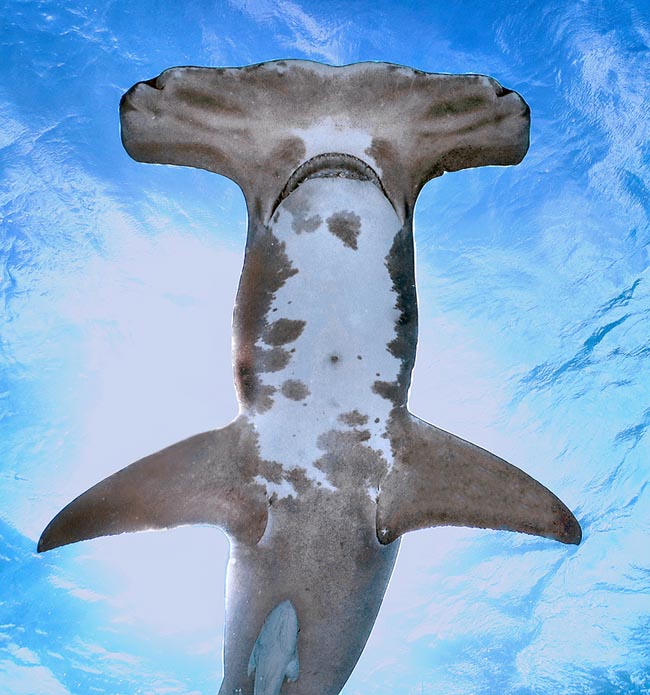
Bigger than Scalloped hammerhead, it easily distinguishes for the showy dorsal fin and the almost straight profile of the snout, with only one clear notch at the centre and two dimples just hinted on the sides, more evident in young © Michael Eisenbart
Zoogeography
Present also in the Mediterranean like the Scalloped hammerhead (Sphyrna lewini), practically circulates in the waters of the tropical and warm temperate seas of the whole world.
The most frequented coasts in the eastern Atlantic go from Morocco to the Guinea-Bissau, whilst on the other Atlantic side it goes swimming along those of North Carolina, of the Caribbean, of Brazil and of Uruguay.
It is found in the Red Sea and is frequent in the Indo-pacific from Africa to India and Sri Lanka and then up to Australia, Malaysia, Philippines, Taiwan, China, Japan, Micronesia, New Caledonia, Hawaii, Tahiti and French Polynesia to finally touch the Baja California and all coasts of Central America up to Peru.
Ecology-Habitat
Sphyrna mokarran is a semi-oceanic migrant species that may go down up to about 300 m of depth but is found usually along the coasts in shallow waters, between 1 and 100 m, while hunting on the sandy bottoms that skirt the madreporic formations.
Unlike Sphyrna lewini, that often moves in dense schools, it is a solitary fish and also in summer, in the migratory period, the movement to cooler waters is done on its own, at most together with the pilot fishes and the remorae, with long distances that can exceed the 1000 km.
Morphophysiology
The Great hammerhead can live 44 years and reach the length of 6 m, with a maximum ascertained weight of 449,5 kg, but the current size is of about 3,7 m.
The big nostrils can perceive one drop of blood at enormous distances, and the eyes, protected by a nictitating membrane, allow a perfect 360° vision.
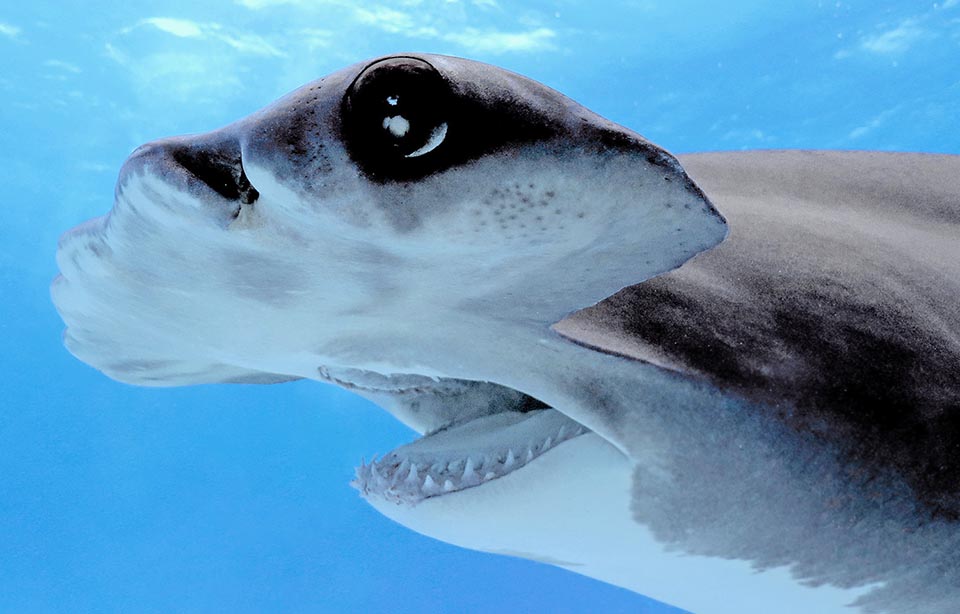
Near to the eye, protected by the nictitating membrane, we note on left a showy nostril and the terminals right, like pores, of the Lorenzini’s ampoules © Michael Eisenbart
Contrary to Sphyrna lewini, the fore profile of the head is almost straight, with only one notch at the centre and two dimples just dimpled on the sides, more evident in the young.
Here also the Ampullae of Lorenzini, visible outside as pores, that detect with extreme precision also the magnetic field emitted by the preys hidden under the sand and memorize the locations, through the terrestrial magnetic field, to find them later on when needed. A precious sensory organ, present in other sharks but here emphasized by the wide and flat shape of the snout with which it sounds the bottoms.
There is no spiracle and the mouth, very arched, has triangular teeth sharp nut serrated on the sides: 28-30 above, leaning inwards with 1-2 working rows and two small teeth at the centre, and 25-32 below, almost vertical, staggered on 2-3 active rows and one small tooth at the centre.
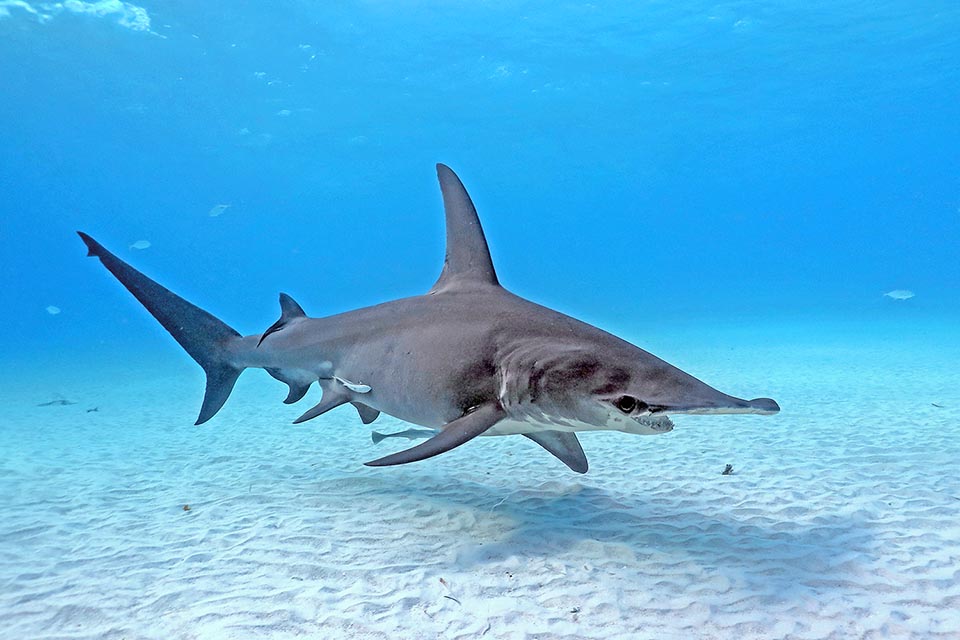
Sphyrna mokarran reaches the length of 6 m, with a current size of 3,7 m. The caudal fin is strongly asymmetric, pectorals are like the first dorsal one © Michael Eisenbart
The first dorsal fin, much tall and falcate, is characteristic, whilst the second, the anal and the pelvic ones, close to the copulatory pterygopodia in the males, are of relatively modest size.
The gill openings are five, the fourth and the fifth at the junction of the big pectoral fins, of analogous size of the dorsal. The caudal is heterocercal, strongly asymmetric. The upper lobe is very long with a pronounced sub apical notch and the well-developed lower one with the rear edge very open, almost perpendicular to the fish.
The Great hammerhead often swims tilted on one side, in the posture defined as rolled, with the great dorsal fin at the horizontal allowing an energy saving.
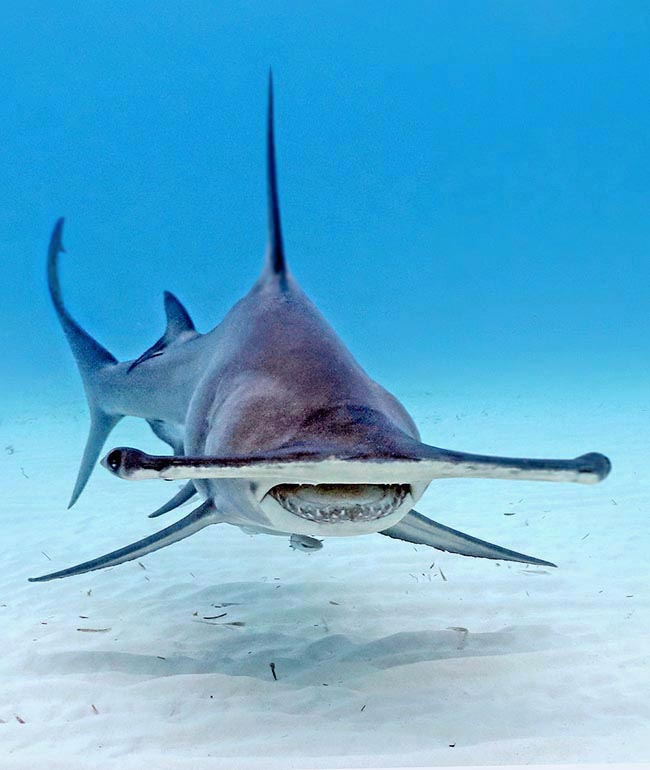
The big hammer head allows a 360° vision and detects, even under the sand, the presence of possible preys © Michael Eisenbart
The skin is protected by scales shaped like a diamond; They have 3-5 keeled crests in the young and 5-6 in the adults and serve to reduce the friction with the water.
The upper part of the body is pale grey or greyish brown, and as usual the ventral side is clear, in a way not to be noticed from above, as it imitates the bottoms, and from below because its silhouette merges with the brightness of the sea.
Ethology-Reproductive Biology
The Great hammerhead goes hunting mainly at dawn or at dusk, nourishing mainly of rays, even big ones, such as Aetobatus ocellatus.
It discovers them while they are resting covered by sand on the bottom and with a rapid movement of the head cuts them at once the fins to prevent their escape and then to eat calmly while the animal bleeds to death. Otherwise, when it finds them swimming not far from the bottom, surprises them by knocking them down with a powerful blow from above and paralyzes them at once, as expected, with a bite to the fins.
It is immune to the stings of the poisonous caudal spines of some rays and even to the tetrodotoxin of the pufferfishes, like Diodon hystrix, or of the boxfishes, and hunts in an opportunistic way all what it finds on the bottoms: groupers and all sort of bony fishes, young sharks, including those of its own species, squids, lobsters and crabs.
In turn, the Great hammerhead is preyed upon in youth by the big sharks like the Tiger shark (Galeocerdo cuvier) and the Great white shark (Carcharodon carcharias) whilst the adults have as enemy only the Killer whale (Orcinus orca) and the man.
Though potentially dangerous, Sphyrna mokarran usually does not attack the divers, even if the man has fished it too much and still is much fished for sport, or, shamelessly, for the shark fin soup particularly in demand in China. Massacres that have seen the populations drastically reduced in all seas and have led the species in the IUCN category “Critically Endangered”, the last step before extinction.
Presently, in 2022, the fishing vulnerability is extremely high, marking 86 on a scale of 100, and this in presence of a low resilience, seen that the minimum doubling time for a population is of 4,5-14 years.
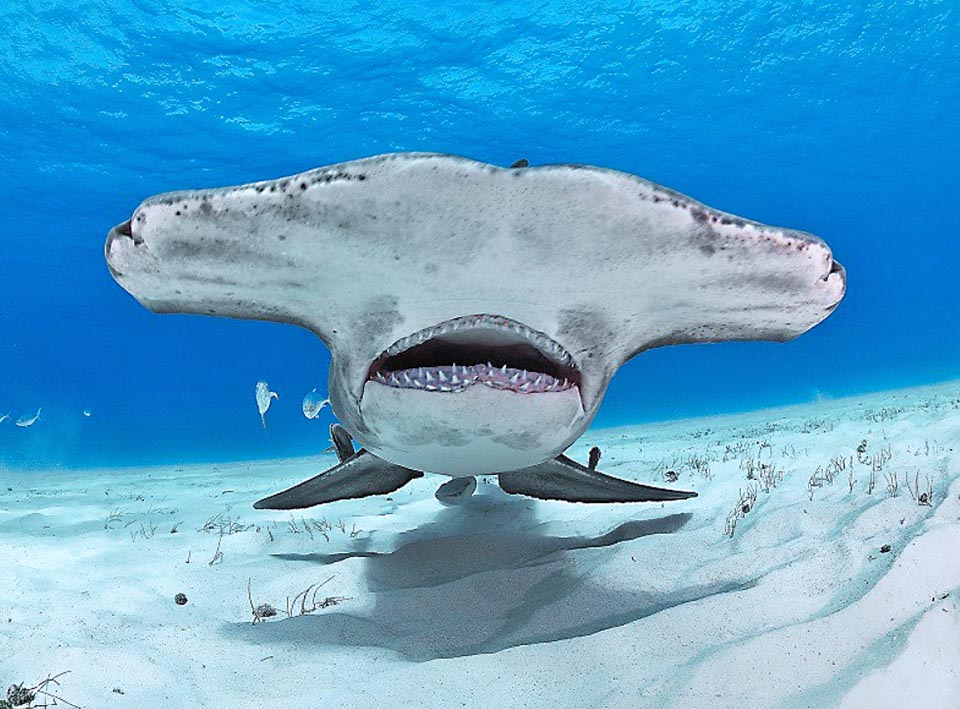
In the very arcuate mouth, we note two rows of teeth above and three under. Does not attack man but in return is too fished and near to extinction © Richard Merritt
The sexual maturity of the Great hammerhead is in fact reached late, around the 5-8 years, when the males exceed the 2,25 of length and the females get close to the 3 m.
It has been observed that the mating of this species occurs, unlike other sharks, in surface with the usual technique: the male grabs with its teeth a pectoral of the female to swim then together for a few minutes, the time necessary for introducing one of its pterygopodia into the cloaca of the partner and dispatch there the sperm.
The development of the embryos takes place inside the womb, but when these have exhausted the reserves of the yolk sac, they do not eat the not fecundated eggs, like Carcharodon carcharias, or the other embryos like Carcharias taurus, where the strongest eats all others, but they connect like Sphyrna lewini to the maternal blood vessels in a sort of placenta.
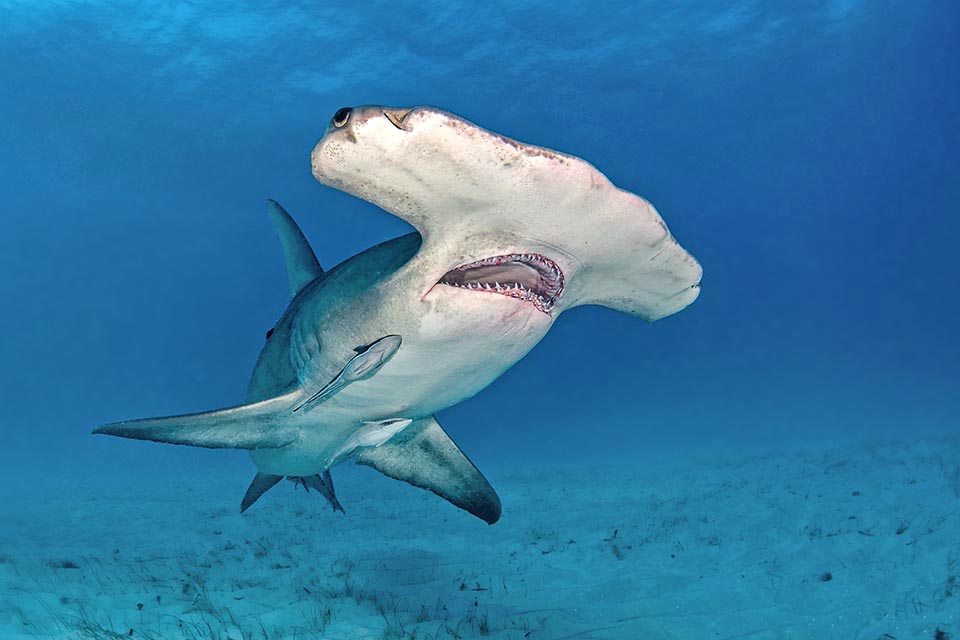
The fishing vulnerability index, very high, marks 86 on a scale of 100. Resilience is low because females deliver every two years and young mature late © David Guillemet
Therefore this is a viviparous species and this allows to deliver, after a pregnancy of about 11 months, 13-42 pups that upon birth measure 50-70 cm. This is a high number if compared to the other sharks, but in first years the mortality is very high and the females, exhausted by pregnancy, reproduce only every two years.
Sphyrna mokarran apparaît sur la Liste rouge des espèces menacées comme “Critically Endangered”, c’est-à-dire à grand risque.
Synonyms
Zygaena mokarran Rüppell, 1837; Zygaena dissimilis Murray, 1887; Sphyrna ligo Fraser-Brunner, 1950.
→ For general information about FISH please click here.
→ For general information about CARTILAGINOUS FISH please click here.
→ For general information about BONY FISH please click here
→ To appreciate the BIODIVERSITY of CARTILAGINOUS FISH please click here.
→ To appreciate the BIODIVERSITY of BONY FISH please click here.
